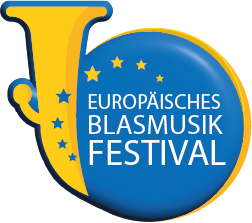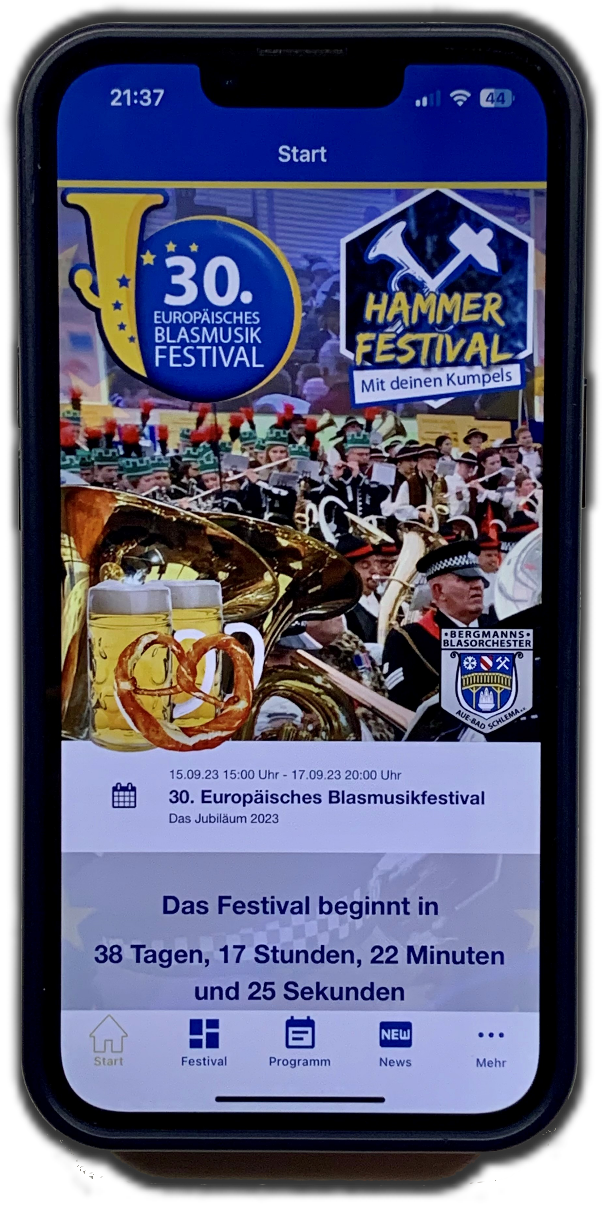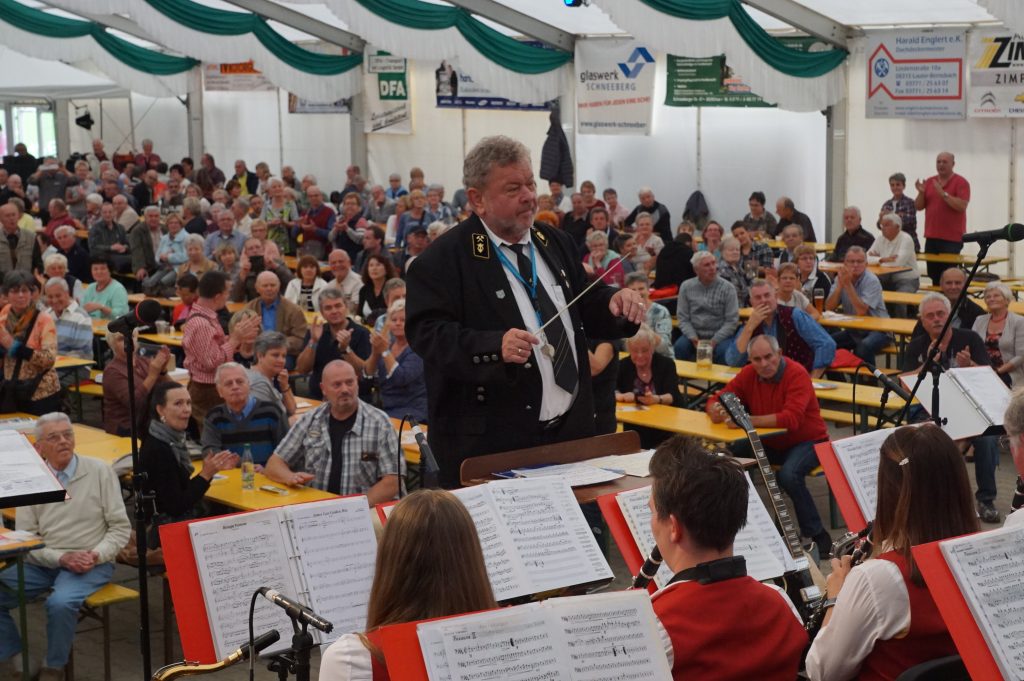
From village fete to international festival
For the 30th time, the Miners’ Brass Orchestra Aue-Bad Schlema celebrates with bands, brass orchestras and brass bands from all over the world in the Erzgebirge Mountains.
„Möge dieses Fest Tradition in Schlema werden und allen frohe und erholsame Stunden bereiten.“ So war es auf dem Plakat zum „1. Fest der Blasmusik“ zu lesen. Das wurde 1992 gefeiert.
“May this festival become a tradition in Schlema and give everyone happy and relaxing hours”. That’s what it said on the poster for the “1st Festival of Brass Music”. This was celebrated in 1992.
“Such a festival belongs where mining has its roots, in Schlema.”
Festival father Stefan Richter
At that time, the board of directors around Managing Director Stefan Richter had no idea what dimensions the celebration would one day take on. Richter received a call from the then chairman of the IGBE trade union, who wanted to honour their jubilarians – but in Chemnitz. “When miners celebrate, it’s in Schlema. Such a celebration belongs where mining has its roots,” Stefan Richter boldly threw into the room.
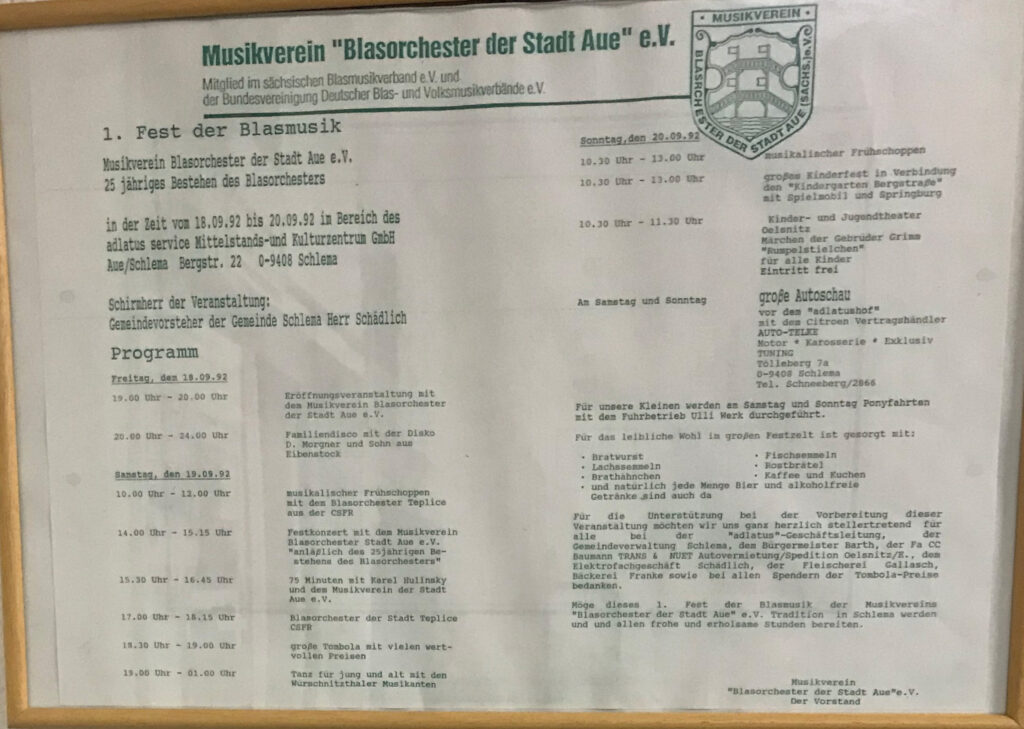
Inspired by the Herrenberg Music Days in Baden-Württemberg, where the miners’ wind orchestra was a guest in 1990, the future chief organiser put his idea into practice. He was supported by the IGBE, which bought 1000 tickets. Since then, the festival has been inseparably linked with the name Stefan Richter.
“The whole affair was a little daring.”
Chief organiser Stefan Richter
It all started with a smaller marquee that was erected below the Kulturhaus Aktivist in Schlema. “The whole thing was a bit risky,” the orchestra chronicle says. It goes on to say, “But now that everything is over, one can say without exaggeration: fantastic!” The hosts, orchestras from Aue and Neuwürschnitz played, there was a family disco, tombola, children’s theatre and a car show. The only orchestra from abroad at the time was the Teplice City Orchestra from the Czech Republic.
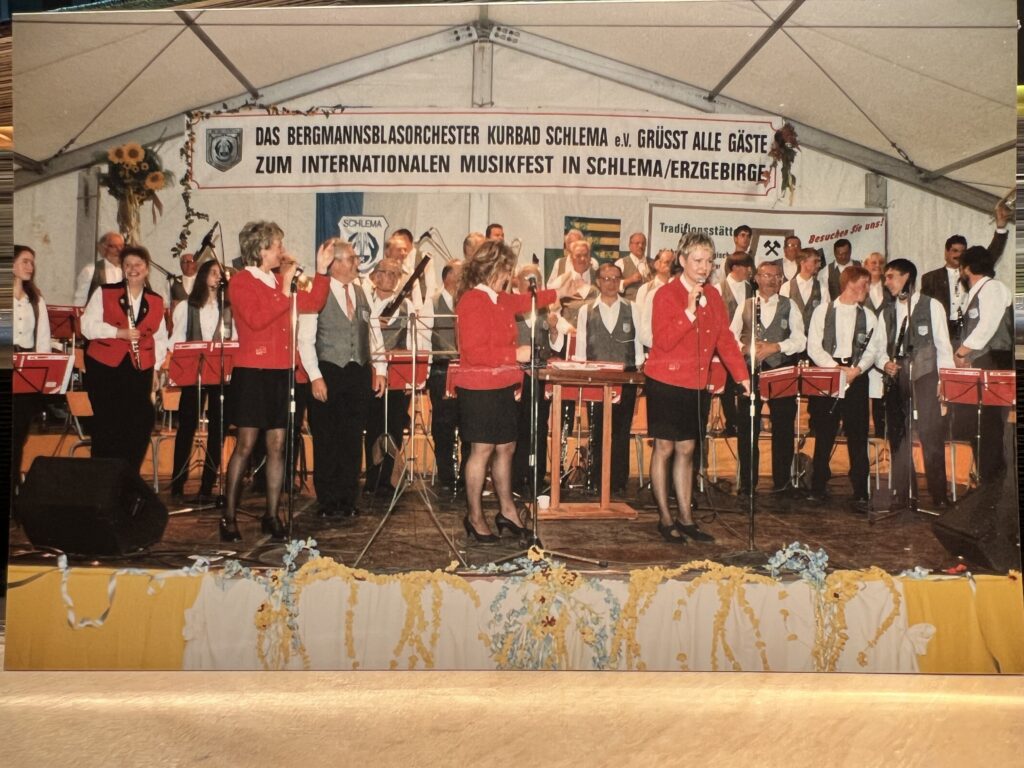
In 1993, the town of Schlema celebrated its 600th anniversary. Therefore, the then mayor Konrad Barth took over the patronage. The festival tent also grew, now had 1200 seats and the musical programme became more extensive. The hosts, six orchestras from the surrounding area and the musicians from Teplice in the Czech Republic were on stage. In the evening, the group Korrosion played for dancing.
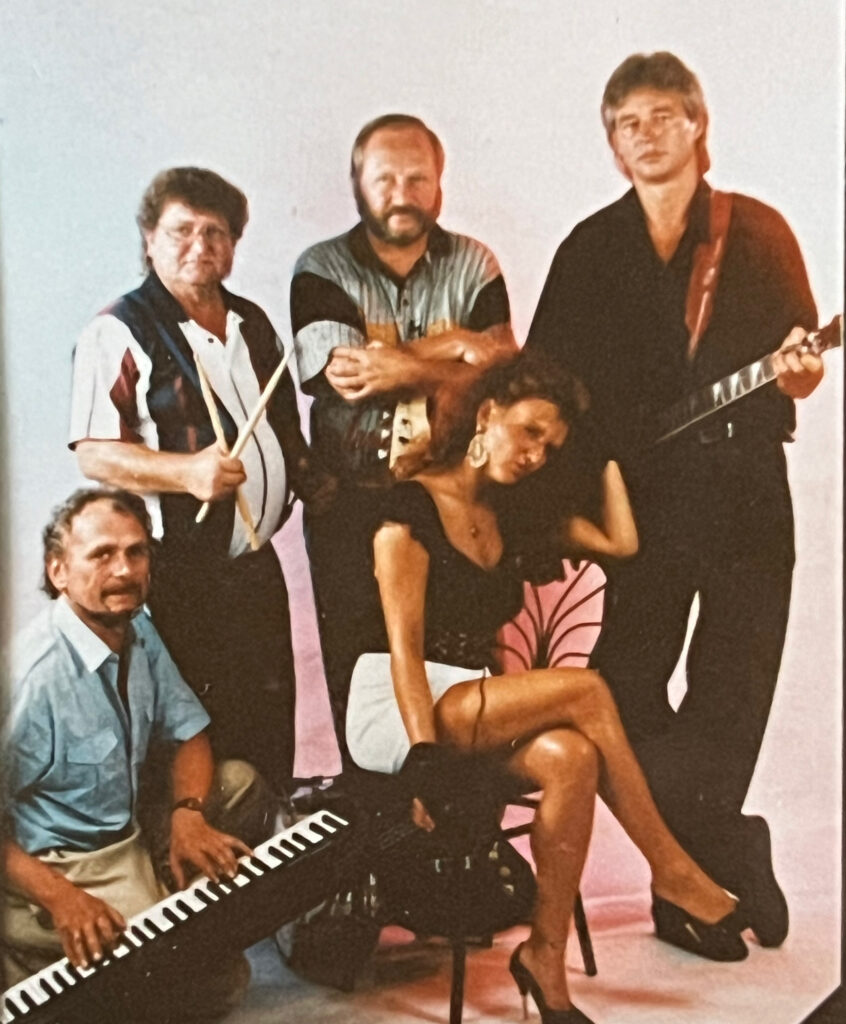
But the guests stayed away. Three days of rain made the event a losing proposition. Despite the resistance, Stefan Richter decided to hold a third music festival. This brought the longed-for success and made the breakthrough.
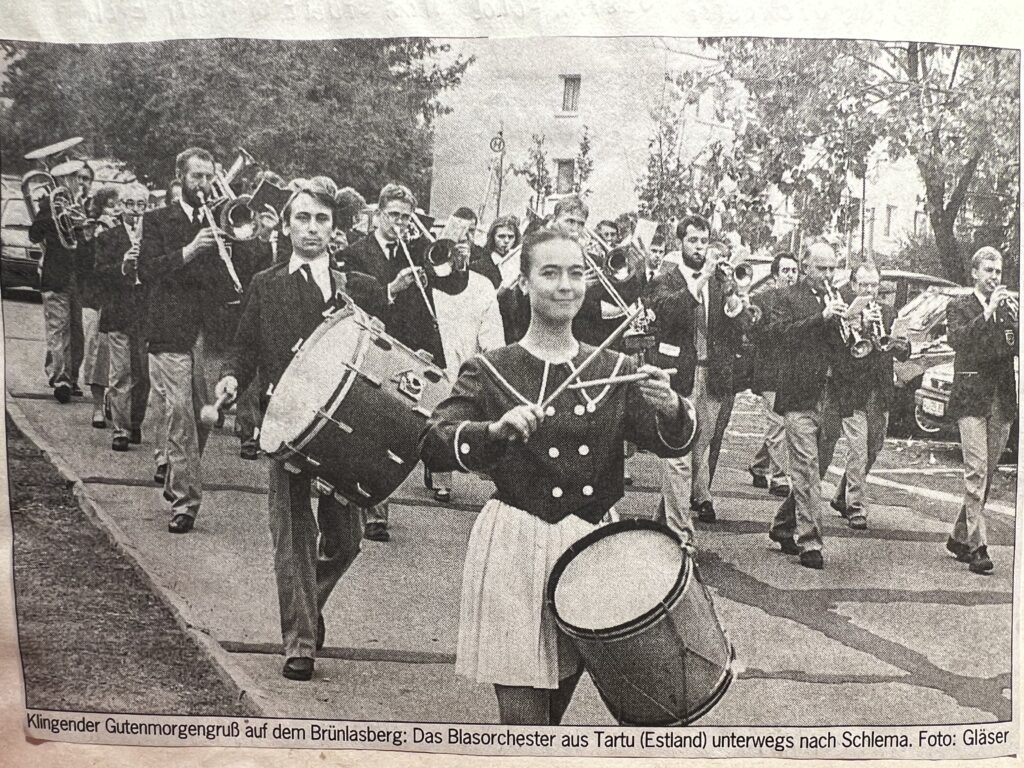
The festival in September 1994 was then called the “3rd International Music Festival”. Orchestras from Italy, Estonia, Poland and the Czech Republic travelled to the up-and-coming spa town of Schlema. The newly built market passage with many shops and a supermarket had a large car park. The miners’ brass orchestra was allowed to use this for an even larger marquee, which now offered seating for 2500 brass music lovers. There was also room for two stages, one at each end. So for the first time it was possible to have non-stop music. While music was being played on one stage, the other stage could be rebuilt.
“On Saturday, when the Italians intoned Verdi’s Triumphal March from the opera Aida and then the Schloßberggeister from Herrenberg gave a performance, the tent cracked and people stood on the benches.”
Orchestra chronicle 1994
The weather was kind to the organisers. Three days of sunshine made the visitors thirsty, so that the volunteers at the beer stand had their hands full. And the wives of the musicians had once again baked delicious cakes and pies, which sold like hot cakes. Anyone who reads the orchestra chronicle can still feel the enthusiasm today.
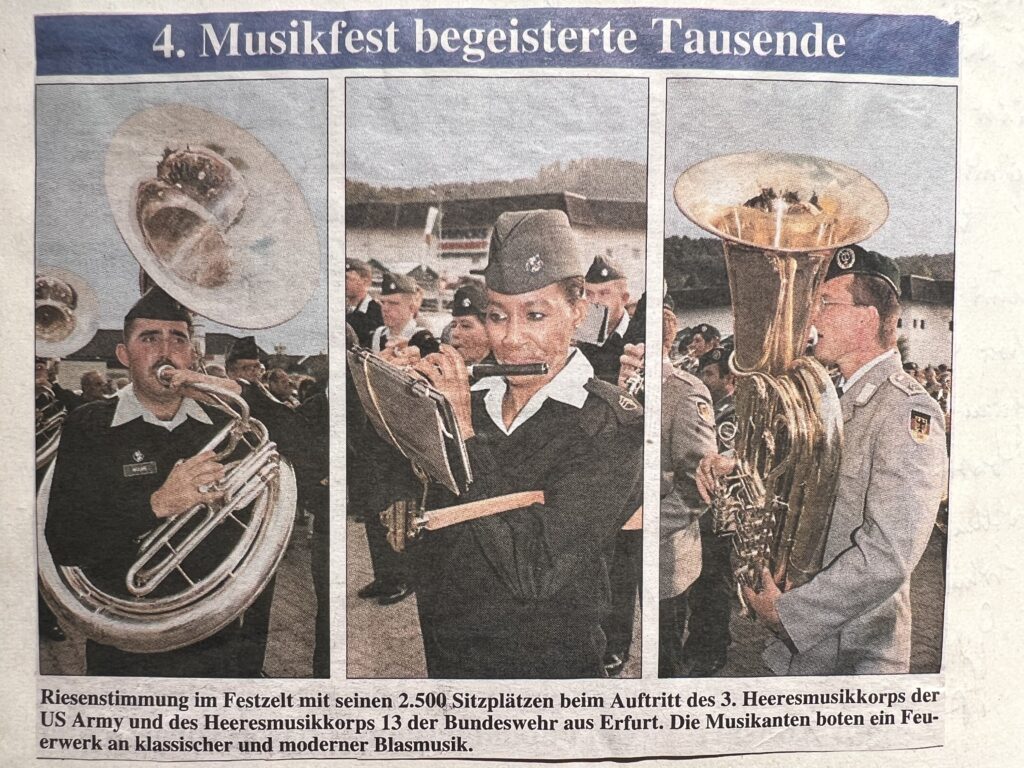
A year later, the big coup came with the patronage, which was taken over by the then Federal Minister of Defence, Volker Rühe. A clever move, because it was the only way Stefan Richter managed to bring the Army Music Corps 13 of the German Armed Forces Erfurt to Schlema. But a military band from the USA also performed for the first time, the 3rd Army Music Corps of the US Army “Marine Band” with a woman at the helm.
“I would like to thank all the participants, the musicians in the spotlight and the helpers behind the scenes for their commitment and dedication. I wish the visitors much enjoyment and good entertainment.”
Volker Rühe, Greeting 1995
Nine orchestras from five countries brought the packed festival tent to life with swing from Glenn Miller, mountain folk songs or Bohemian brass music.
“Even the musicians from abroad were thrilled with the atmosphere in the marquee, they all want to come again next year.”
Orchestra chronicle 1996
In 1996, 600 musicians from seven countries travelled to the Erzgebirge and made Schlema the brass band capital of Europe once and for all.
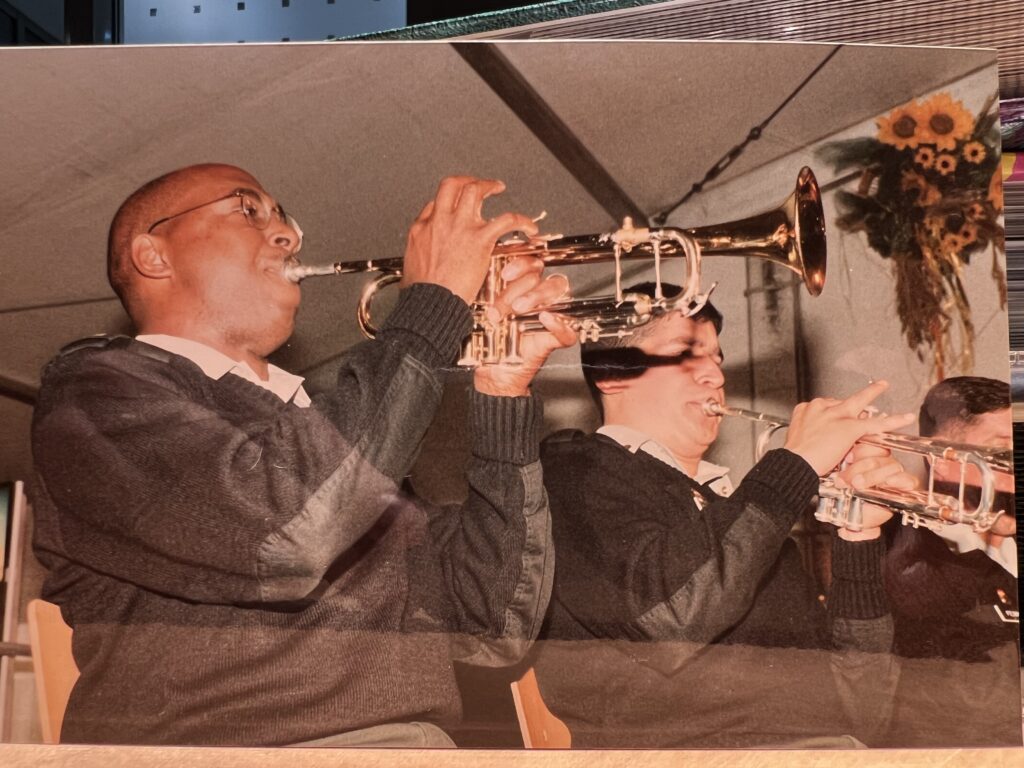
The festival developed rapidly and was named the European Wind Music Festival in 1998. In the meantime, orchestras from other continents have also performed in the now 3500-person festival tent.
Altogether 195 orchestras from 33 nations (until 2024) have been hosted by the Miners’ Brass Band Aue-Bad Schlema, listed below in alphabetical order:
Australia, Austria, Belarus, Belgium, Croatia, Cyprus, Czech Republic, Denmark, Estonia, Finland, France, Germany, Hungary, Ireland, Israel, Italy, Japan, Lithuania, Luxembourg, Netherlands, Northern Ireland, Norway, Poland, Russia, Scotland, Slovenia, Spain, Sweden, Switzerland, Ukraine, USA.
Since then, patrons have included:
• Ingrid Biedenkopf, wife of the then Prime Minister of Saxony Kurt Biedenkopf
• Madam Viviane Reding from Luxembourg, Commissioner for Culture of the European Union
• State councillors, district presidents, Saxon state ministers and prime ministers, managing directors of sponsors.
One situation is still on many people’s minds: the terrorist attack on the World Trade Center in New York. That was on Tuesday, 11.09.2001. Three days later, on 14.09.2001, the festival was to open. Again, an American orchestra was on the programme. Stefan Richter did not dare to contact the Americans. But they got in touch themselves and asked if the festival would go ahead: “We are sitting on packed suitcases. If you hold the festival, we will definitely come.”
“The festival grounds were dressed in mourning and the first song the Americans played in the marquee was “New York, New York”. Never again have I had such goose bumps.”
Stefan Richter in September 2001
The chief organiser had a load off his mind. The musicians of the US Army First Infantry Division Band were the stars of the 2001 festival.
The European Wind Music Festival has a lot to tell about international understanding. For example, the first meeting of an orchestra from Ireland and Great Britain in 2010. The musicians of the Dublin Concert Band had expressed concerns about a meeting with the musicians of the police orchestra “Band and Drums of the Cheshire Constabulary” from Great Britain, which was also a guest. The background to these concerns was that some members of the police orchestra had been stationed there during the conflicts between Ireland and Great Britain. The war in their own country had made people suspicious. Two musicians from both orchestras happened to meet while going to the toilet. After the two were back in the marquee, everyone could see how gradually more and more British and Irish people met and laughed together.
“We’ll have to meet in Germany first to be on friendly terms.”
Musiker aus Dublin 2010
Since that moment, both orchestras have always played the last two titles together at their Festival performances, whenever they were invited at the same time. Both orchestras still maintain friendly contact with each other to this day.
Seitdem haben beide Orchester bei ihren Festivalauftritten immer die letzten beiden Titel gemeinsam gespielt, wenn sie gleichzeitig eingeladen wurden. Beide Orchester pflegen auch heute noch freundschaftliche Kontakte zueinander.
For the preparation and implementation of the brass music festival, the Miners’ Wind Orchestra Aue-Bad Schlema was honoured by the Federal Association of German Music Associations at the International Music Fair in Frankfurt am Main in 2002 as the “Federal Winner and 1st Honorary Award Winner for Innovative, Modern and Voluntarily Committed Association Work” out of more than 172 German music associations that had applied.
To mark the 30th anniversary of the European Brass Music Festival, there were 54 concerts by 16 orchestras from 11 countries and a brilliant laser show with videos from the past. Not forgetting the two parades on Friday and Sunday. Another highlight every year: the opening concert, where almost 700 musicians play together even though they have never rehearsed together before.
“For the anniversary, we invited orchestras whose performances over the past decades have made the festival a unique event beyond the borders of Germany.”
Thomas Schaumberger, President Bergmannsblasorchester Aue-Bad Schlema
In 2018, the Colombians were the first South Americans ever to wow the Erzgebirge at this festival. Banda Sinfónica La Estrella also took part in the Day of the Saxons in Aue-Bad Schlema in 2023 and got people in the mood for a boundless atmosphere at the largest folk festival in the Free State.
General information
The European Brass Band Festival is organised every year by the Aue-Bad Schlema Miners’ Brass Band Association. The scope, nature and programme of the music festival are considered unique in Europe and are the reason for the event’s unique selling points. The European Brass Music Festival is a major annual event that unites nations. First-class orchestras from at least eight European countries, which are highly regarded in their respective home countries, perform in the spa town of Bad Schlema. Over the three days of the festival, the audience experiences between 40 and 50 top-quality concerts from various brass music genres, which are performed on two large stages in a heated and fully catered marquee with 3,500 seats in a non-stop programme. Two large parades, each with up to 1,000 participants, frame the music event. The various brass music genres represent the diversity of this music from all parts of Europe, but now also from the continents of Asia, America and Australia. They range from swing and big band sounds to light-hearted muse, folk music and arrangements of modern rock and pop music. Classical and concertante pieces are also masterfully interpreted. Music knows no boundaries, connects people and overcomes any language barrier. Music expresses emotions in many different ways and brings cultures closer together. The European Brass Music Festival is not a competition, but serves solely to bring together and forge friendships between high-ranking European wind orchestras and a broad audience of wind music lovers. The entire festival site is designed to be barrier-free and accessible to the disabled – including wheelchair-accessible tables and disabled toilets. There is ample parking for cars and coaches. Every year, up to 15,000 music-loving visitors from all German states and other European countries make the pilgrimage to the European Brass Music Festival. The event is regarded as an established music highlight that numerous travel companies have firmly included in their programmes.
We arer always looking for new brass bands wishing to participate at the European Brass Band Festival. If interested, please contact us – preferably with a written application (incl. photo and brief chronicle of development and the main performances at home and abroad).
